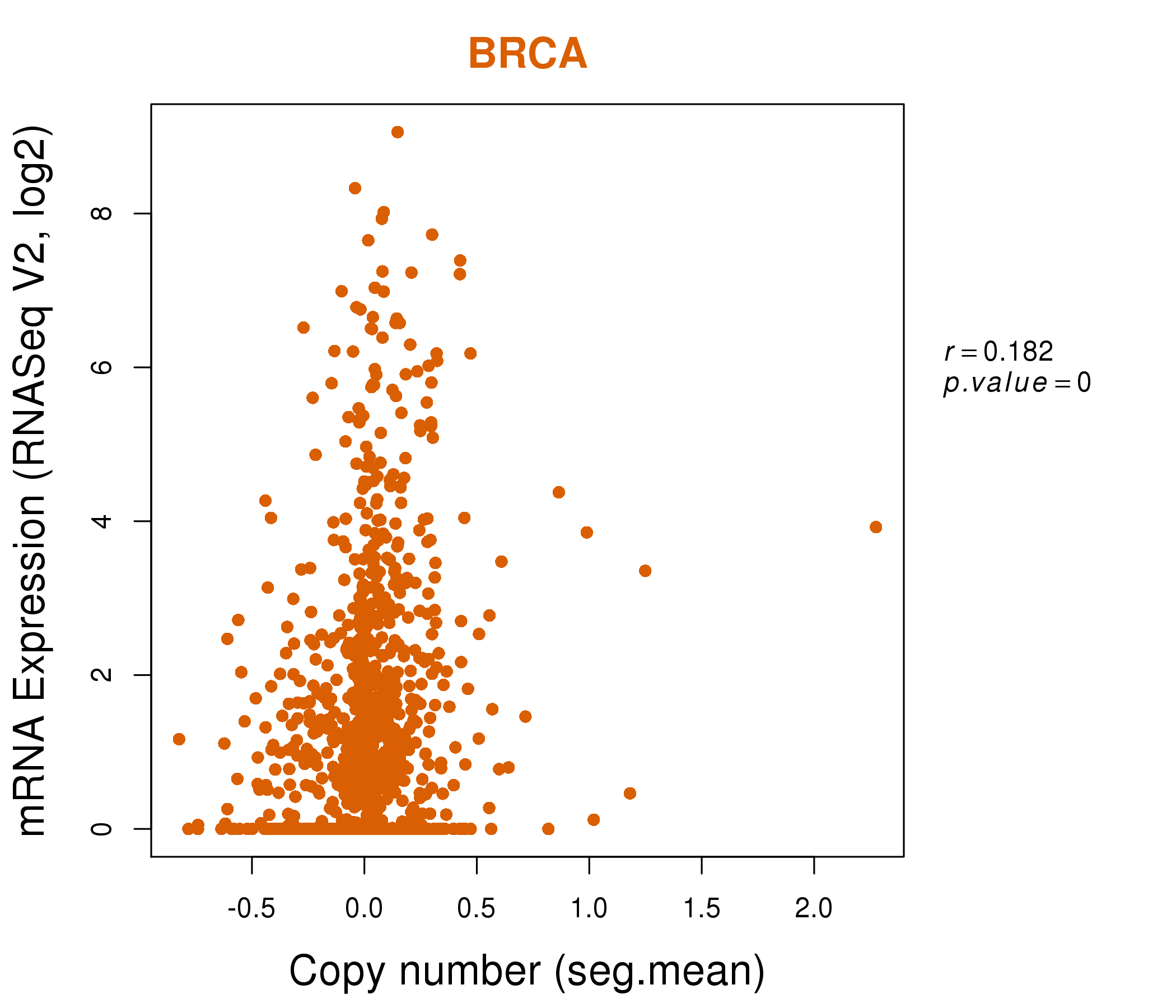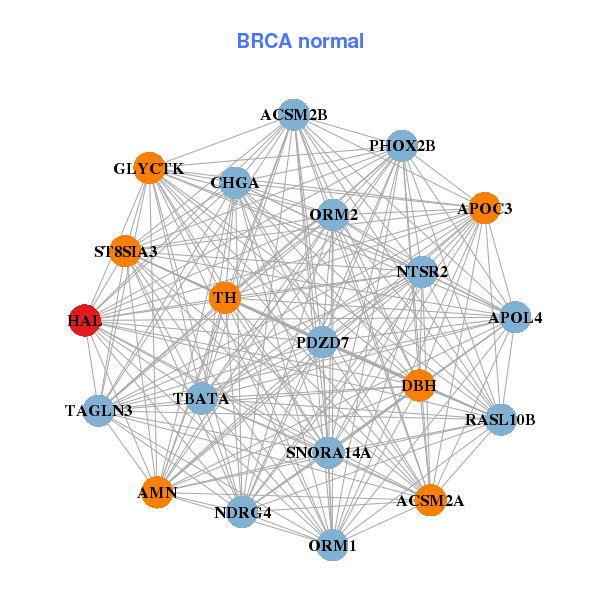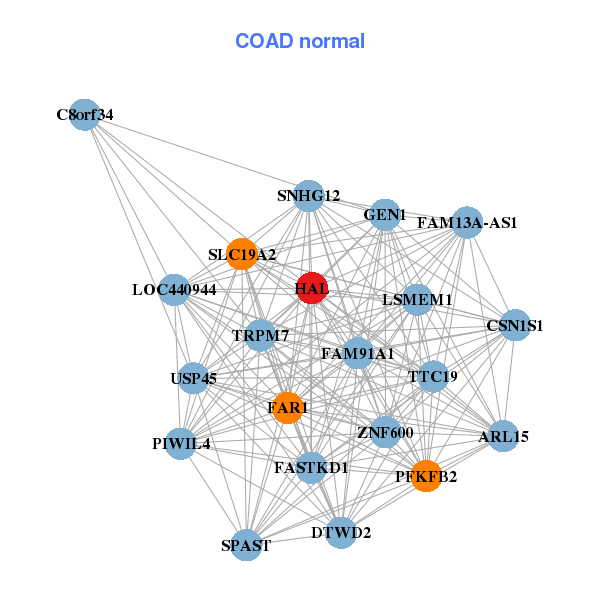|
|||||||||||||||||||||||||||||||||||||||||||||||||||||||||||||||||||||||||||||||||||||||||||||||||||||||||||||||||||||||||||||||||||||||||||||||||||||||||||||||||||||||||||||||||||||||||||||||||||||||||||||||||||||||||||||||||||||||||||||||||||||||||||||||||||||||||||||||||||||||||||||||||||||||||||||||||||||||||||||||||||||||||||||||||||||||||||||||
| |
| Phenotypic Information (metabolism pathway, cancer, disease, phenome) |
| |
| |
| Gene-Gene Network Information: Co-Expression Network, Interacting Genes & KEGG |
| |
|
| Gene Summary for HAL |
| Basic gene info. | Gene symbol | HAL |
| Gene name | histidine ammonia-lyase | |
| Synonyms | HIS|HSTD | |
| Cytomap | UCSC genome browser: 12q22-q24.1 | |
| Genomic location | chr12 :96366439-96390143 | |
| Type of gene | protein-coding | |
| RefGenes | NM_001258333.1, NM_001258334.1,NM_002108.3, | |
| Ensembl id | ENSG00000084110 | |
| Description | histidase | |
| Modification date | 20141207 | |
| dbXrefs | MIM : 609457 | |
| HGNC : HGNC | ||
| Ensembl : ENSG00000084110 | ||
| HPRD : 07187 | ||
| Vega : OTTHUMG00000170354 | ||
| Protein | UniProt: go to UniProt's Cross Reference DB Table | |
| Expression | CleanEX: HS_HAL | |
| BioGPS: 3034 | ||
| Gene Expression Atlas: ENSG00000084110 | ||
| The Human Protein Atlas: ENSG00000084110 | ||
| Pathway | NCI Pathway Interaction Database: HAL | |
| KEGG: HAL | ||
| REACTOME: HAL | ||
| ConsensusPathDB | ||
| Pathway Commons: HAL | ||
| Metabolism | MetaCyc: HAL | |
| HUMANCyc: HAL | ||
| Regulation | Ensembl's Regulation: ENSG00000084110 | |
| miRBase: chr12 :96,366,439-96,390,143 | ||
| TargetScan: NM_001258333 | ||
| cisRED: ENSG00000084110 | ||
| Context | iHOP: HAL | |
| cancer metabolism search in PubMed: HAL | ||
| UCL Cancer Institute: HAL | ||
| Assigned class in ccmGDB | C | |
| Top |
| Phenotypic Information for HAL(metabolism pathway, cancer, disease, phenome) |
| Cancer | CGAP: HAL |
| Familial Cancer Database: HAL | |
| * This gene is included in those cancer gene databases. |
|
|
|
|
|
| . | |||||||||||||||||||||||||||||||||||||||||||||||||||||||||||||||||||||||||||||||||||||||||||||||||||||||||||||||||||||||||||||||||||||||||||||||||||||||||||||||||||||||||||||||||||||||||||||||||||||||||||||||||||||||||||||||||||||||||||||||||||||||||||||||||||||||||||||||||||||||||||||||||||||||||||||||||||||||||||||||||||||||||||||||||||||||||
Oncogene 1 | Significant driver gene in | ||||||||||||||||||||||||||||||||||||||||||||||||||||||||||||||||||||||||||||||||||||||||||||||||||||||||||||||||||||||||||||||||||||||||||||||||||||||||||||||||||||||||||||||||||||||||||||||||||||||||||||||||||||||||||||||||||||||||||||||||||||||||||||||||||||||||||||||||||||||||||||||||||||||||||||||||||||||||||||||||||||||||||||||||||||||||||||||
| cf) number; DB name 1 Oncogene; http://nar.oxfordjournals.org/content/35/suppl_1/D721.long, 2 Tumor Suppressor gene; https://bioinfo.uth.edu/TSGene/, 3 Cancer Gene Census; http://www.nature.com/nrc/journal/v4/n3/abs/nrc1299.html, 4 CancerGenes; http://nar.oxfordjournals.org/content/35/suppl_1/D721.long, 5 Network of Cancer Gene; http://ncg.kcl.ac.uk/index.php, 1Therapeutic Vulnerabilities in Cancer; http://cbio.mskcc.org/cancergenomics/statius/ |
| KEGG_HISTIDINE_METABOLISM KEGG_NITROGEN_METABOLISM REACTOME_METABOLISM_OF_AMINO_ACIDS_AND_DERIVATIVES | |
| OMIM | |
| Orphanet | |
| Disease | KEGG Disease: HAL |
| MedGen: HAL (Human Medical Genetics with Condition) | |
| ClinVar: HAL | |
| Phenotype | MGI: HAL (International Mouse Phenotyping Consortium) |
| PhenomicDB: HAL | |
| Mutations for HAL |
| * Under tables are showing count per each tissue to give us broad intuition about tissue specific mutation patterns.You can go to the detailed page for each mutation database's web site. |
| There's no structural variation information in COSMIC data for this gene. |
| * From mRNA Sanger sequences, Chitars2.0 arranged chimeric transcripts. This table shows HAL related fusion information. |
| ID | Head Gene | Tail Gene | Accession | Gene_a | qStart_a | qEnd_a | Chromosome_a | tStart_a | tEnd_a | Gene_a | qStart_a | qEnd_a | Chromosome_a | tStart_a | tEnd_a |
| Top |
| Mutation type/ Tissue ID | brca | cns | cerv | endome | haematopo | kidn | Lintest | liver | lung | ns | ovary | pancre | prost | skin | stoma | thyro | urina | |||
| Total # sample | 1 | 2 | ||||||||||||||||||
| GAIN (# sample) | ||||||||||||||||||||
| LOSS (# sample) | 1 | 2 |
| cf) Tissue ID; Tissue type (1; Breast, 2; Central_nervous_system, 3; Cervix, 4; Endometrium, 5; Haematopoietic_and_lymphoid_tissue, 6; Kidney, 7; Large_intestine, 8; Liver, 9; Lung, 10; NS, 11; Ovary, 12; Pancreas, 13; Prostate, 14; Skin, 15; Stomach, 16; Thyroid, 17; Urinary_tract) |
| Top |
|
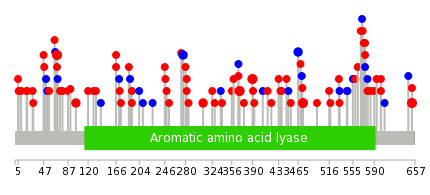 |
| Top |
| Stat. for Non-Synonymous SNVs (# total SNVs=66) | (# total SNVs=13) |
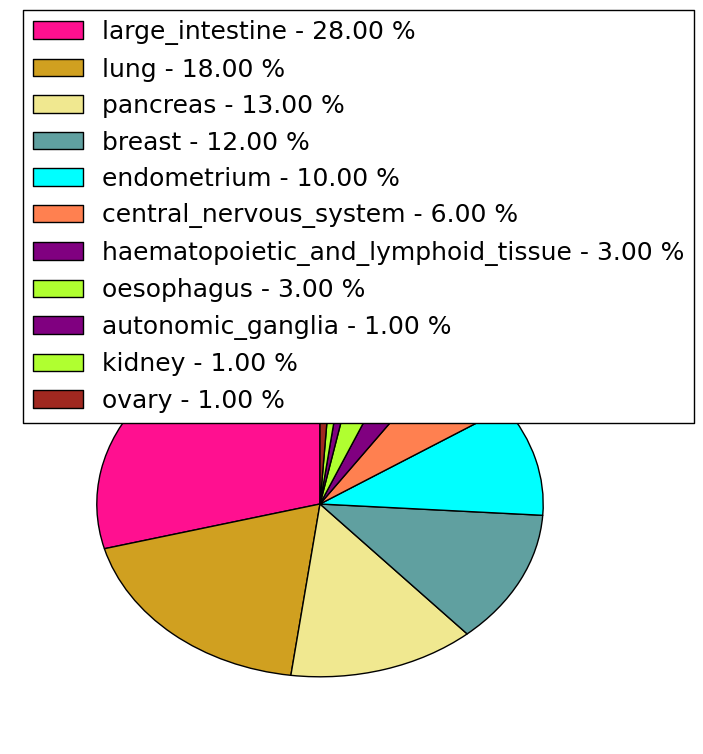 | 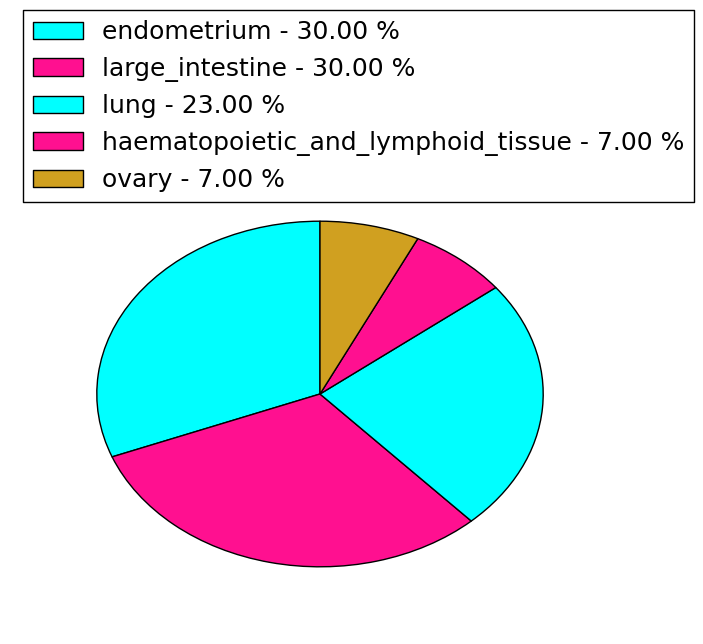 |
(# total SNVs=0) | (# total SNVs=0) |
| Top |
| * When you move the cursor on each content, you can see more deailed mutation information on the Tooltip. Those are primary_site,primary_histology,mutation(aa),pubmedID. |
| GRCh37 position | Mutation(aa) | Unique sampleID count |
| chr12:96374435-96374435 | p.R473L | 3 |
| chr12:96368029-96368029 | p.P652L | 3 |
| chr12:96379724-96379724 | p.R390C | 3 |
| chr12:96379885-96379885 | p.R369W | 3 |
| chr12:96389483-96389483 | p.R69Q | 3 |
| chr12:96379891-96379891 | p.R367R | 2 |
| chr12:96387243-96387243 | p.R192H | 2 |
| chr12:96388721-96388721 | p.G100R | 2 |
| chr12:96370493-96370493 | p.? | 2 |
| chr12:96384198-96384198 | p.P276P | 2 |
| Top |
|
 |
| Point Mutation/ Tissue ID | 1 | 2 | 3 | 4 | 5 | 6 | 7 | 8 | 9 | 10 | 11 | 12 | 13 | 14 | 15 | 16 | 17 | 18 | 19 | 20 |
| # sample | 4 | 2 | 13 | 2 | 2 | 1 | 3 | 2 | 2 | 16 | 3 | 8 | ||||||||
| # mutation | 4 | 2 | 13 | 2 | 2 | 1 | 3 | 2 | 2 | 16 | 3 | 9 | ||||||||
| nonsynonymous SNV | 2 | 2 | 9 | 2 | 2 | 1 | 3 | 2 | 1 | 9 | 2 | 6 | ||||||||
| synonymous SNV | 2 | 4 | 1 | 7 | 1 | 3 |
| cf) Tissue ID; Tissue type (1; BLCA[Bladder Urothelial Carcinoma], 2; BRCA[Breast invasive carcinoma], 3; CESC[Cervical squamous cell carcinoma and endocervical adenocarcinoma], 4; COAD[Colon adenocarcinoma], 5; GBM[Glioblastoma multiforme], 6; Glioma Low Grade, 7; HNSC[Head and Neck squamous cell carcinoma], 8; KICH[Kidney Chromophobe], 9; KIRC[Kidney renal clear cell carcinoma], 10; KIRP[Kidney renal papillary cell carcinoma], 11; LAML[Acute Myeloid Leukemia], 12; LUAD[Lung adenocarcinoma], 13; LUSC[Lung squamous cell carcinoma], 14; OV[Ovarian serous cystadenocarcinoma ], 15; PAAD[Pancreatic adenocarcinoma], 16; PRAD[Prostate adenocarcinoma], 17; SKCM[Skin Cutaneous Melanoma], 18:STAD[Stomach adenocarcinoma], 19:THCA[Thyroid carcinoma], 20:UCEC[Uterine Corpus Endometrial Carcinoma]) |
| Top |
| * We represented just top 10 SNVs. When you move the cursor on each content, you can see more deailed mutation information on the Tooltip. Those are primary_site, primary_histology, mutation(aa), pubmedID. |
| Genomic Position | Mutation(aa) | Unique sampleID count |
| chr12:96387243 | p.R360C,HAL | 2 |
| chr12:96370437 | p.P68P,HAL | 2 |
| chr12:96384198 | p.R192L,HAL | 2 |
| chr12:96370403 | p.R182C,HAL | 1 |
| chr12:96389484 | p.G171G,HAL | 1 |
| chr12:96374496 | p.A20T,HAL | 1 |
| chr12:96380882 | p.H177Y,HAL | 1 |
| chr12:96387251 | p.I166M,HAL | 1 |
| chr12:96370416 | p.G355D,HAL | 1 |
| chr12:96389491 | p.R161W,HAL | 1 |
| * Copy number data were extracted from TCGA using R package TCGA-Assembler. The URLs of all public data files on TCGA DCC data server were gathered on Jan-05-2015. Function ProcessCNAData in TCGA-Assembler package was used to obtain gene-level copy number value which is calculated as the average copy number of the genomic region of a gene. |
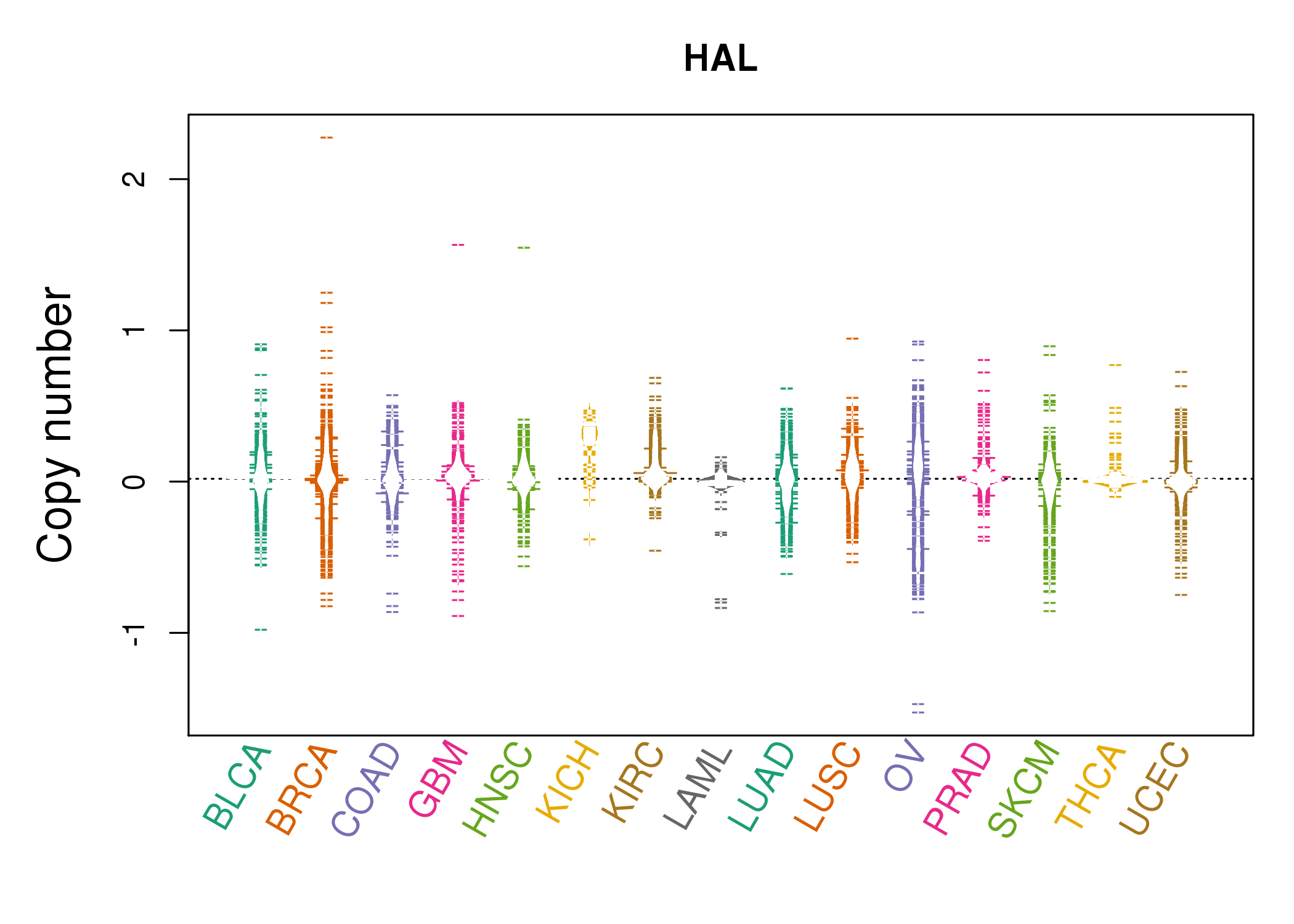 |
| cf) Tissue ID[Tissue type]: BLCA[Bladder Urothelial Carcinoma], BRCA[Breast invasive carcinoma], CESC[Cervical squamous cell carcinoma and endocervical adenocarcinoma], COAD[Colon adenocarcinoma], GBM[Glioblastoma multiforme], Glioma Low Grade, HNSC[Head and Neck squamous cell carcinoma], KICH[Kidney Chromophobe], KIRC[Kidney renal clear cell carcinoma], KIRP[Kidney renal papillary cell carcinoma], LAML[Acute Myeloid Leukemia], LUAD[Lung adenocarcinoma], LUSC[Lung squamous cell carcinoma], OV[Ovarian serous cystadenocarcinoma ], PAAD[Pancreatic adenocarcinoma], PRAD[Prostate adenocarcinoma], SKCM[Skin Cutaneous Melanoma], STAD[Stomach adenocarcinoma], THCA[Thyroid carcinoma], UCEC[Uterine Corpus Endometrial Carcinoma] |
| Top |
| Gene Expression for HAL |
| * CCLE gene expression data were extracted from CCLE_Expression_Entrez_2012-10-18.res: Gene-centric RMA-normalized mRNA expression data. |
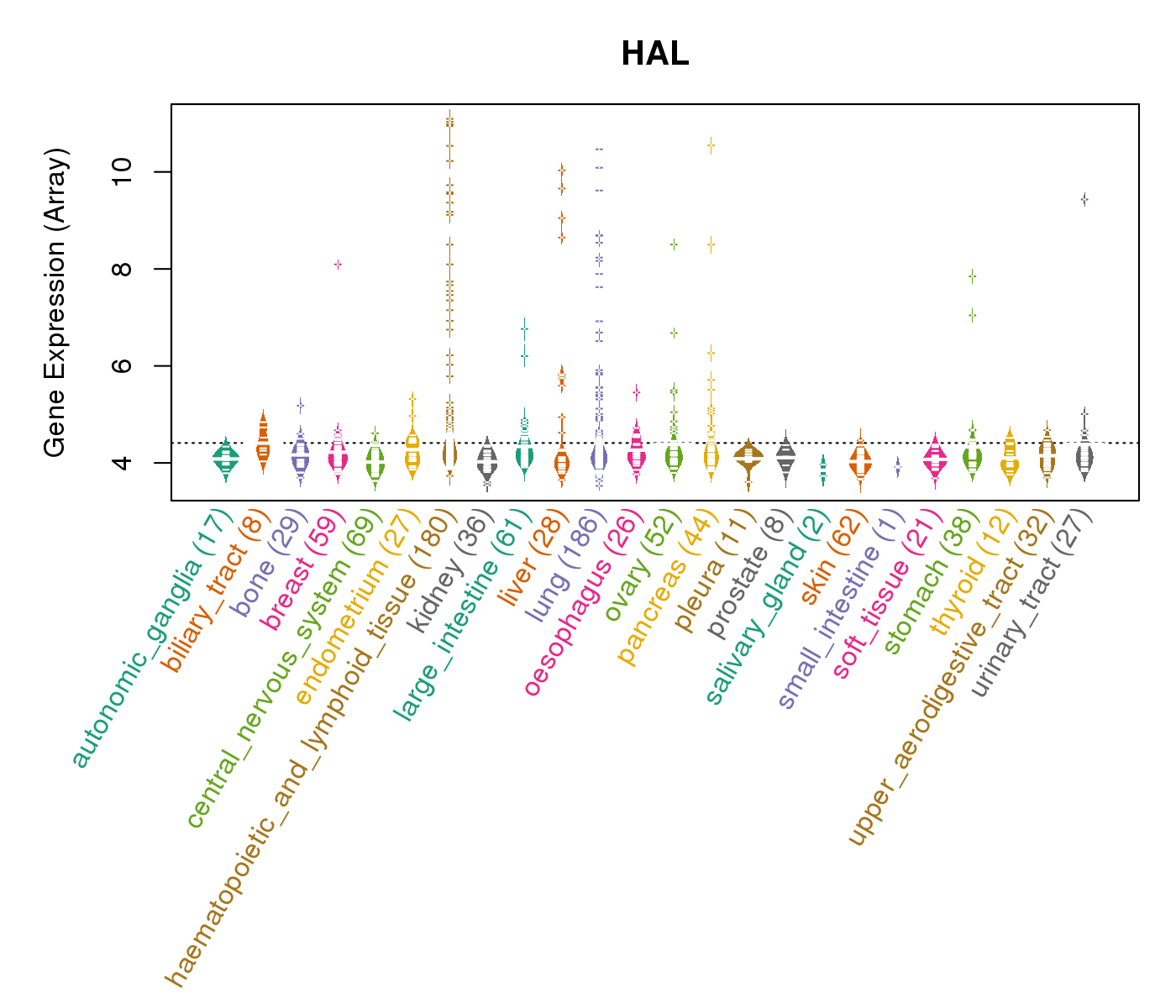 |
| * Normalized gene expression data of RNASeqV2 was extracted from TCGA using R package TCGA-Assembler. The URLs of all public data files on TCGA DCC data server were gathered at Jan-05-2015. Only eight cancer types have enough normal control samples for differential expression analysis. (t test, adjusted p<0.05 (using Benjamini-Hochberg FDR)) |
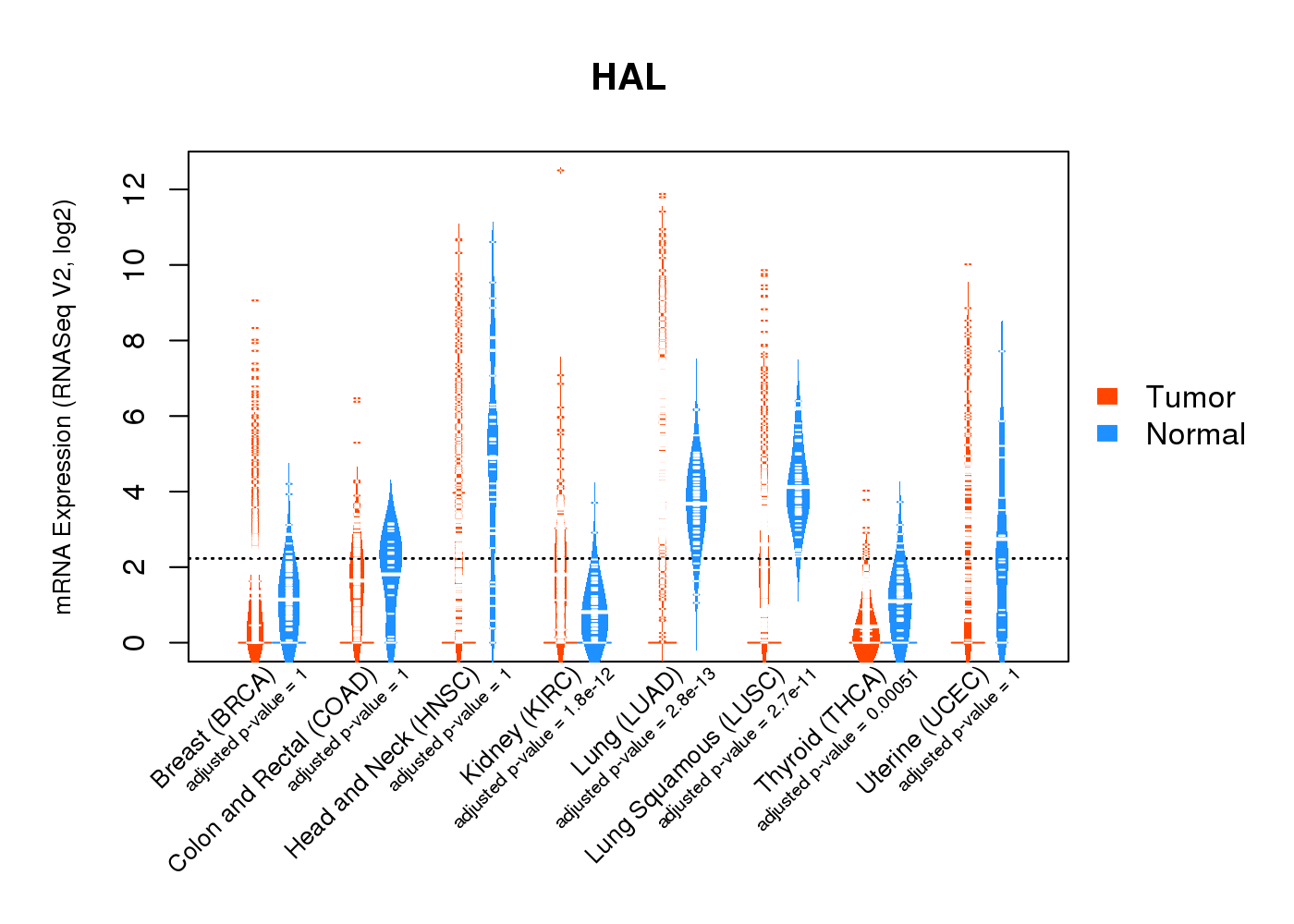 |
| Top |
| * This plots show the correlation between CNV and gene expression. |
: Open all plots for all cancer types
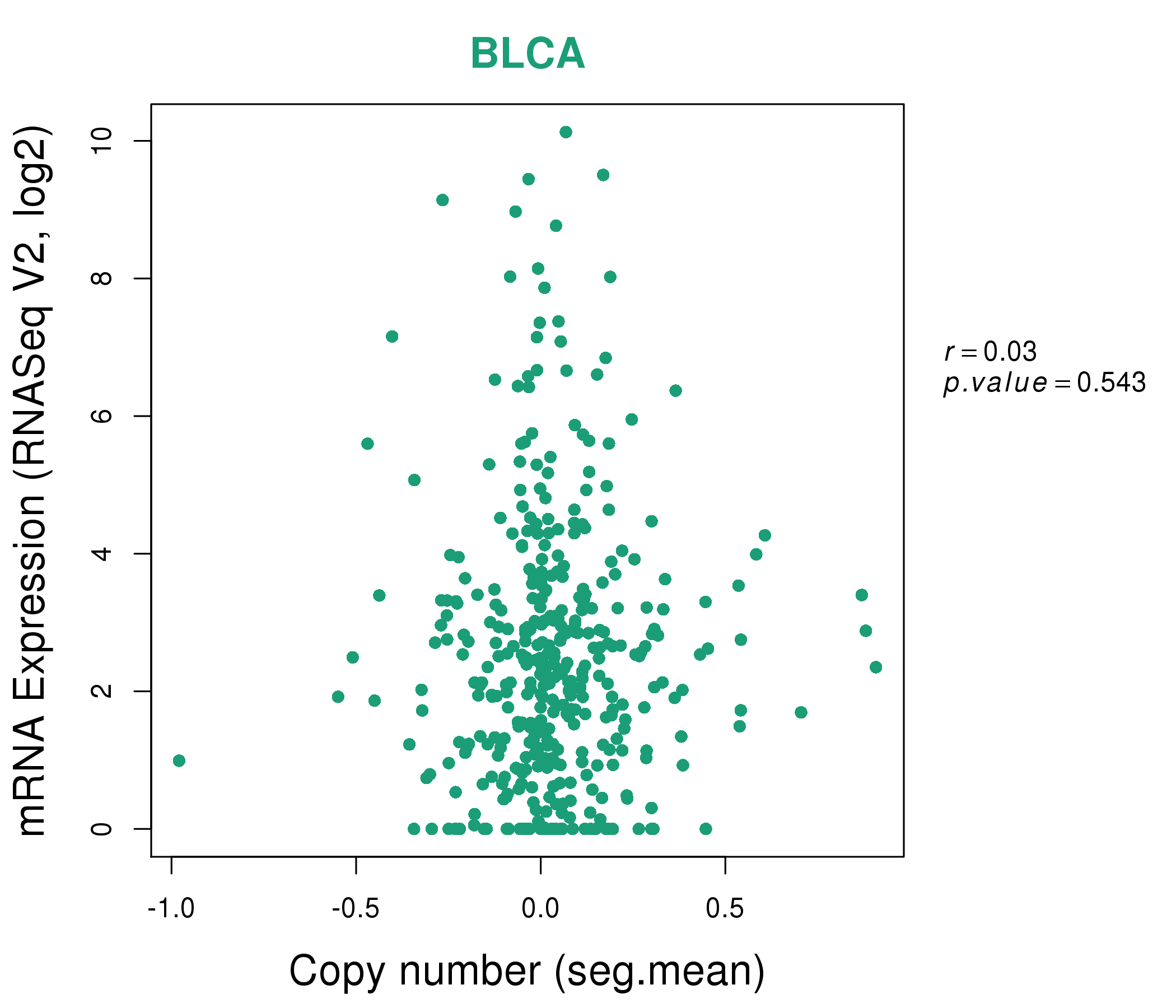 |
|
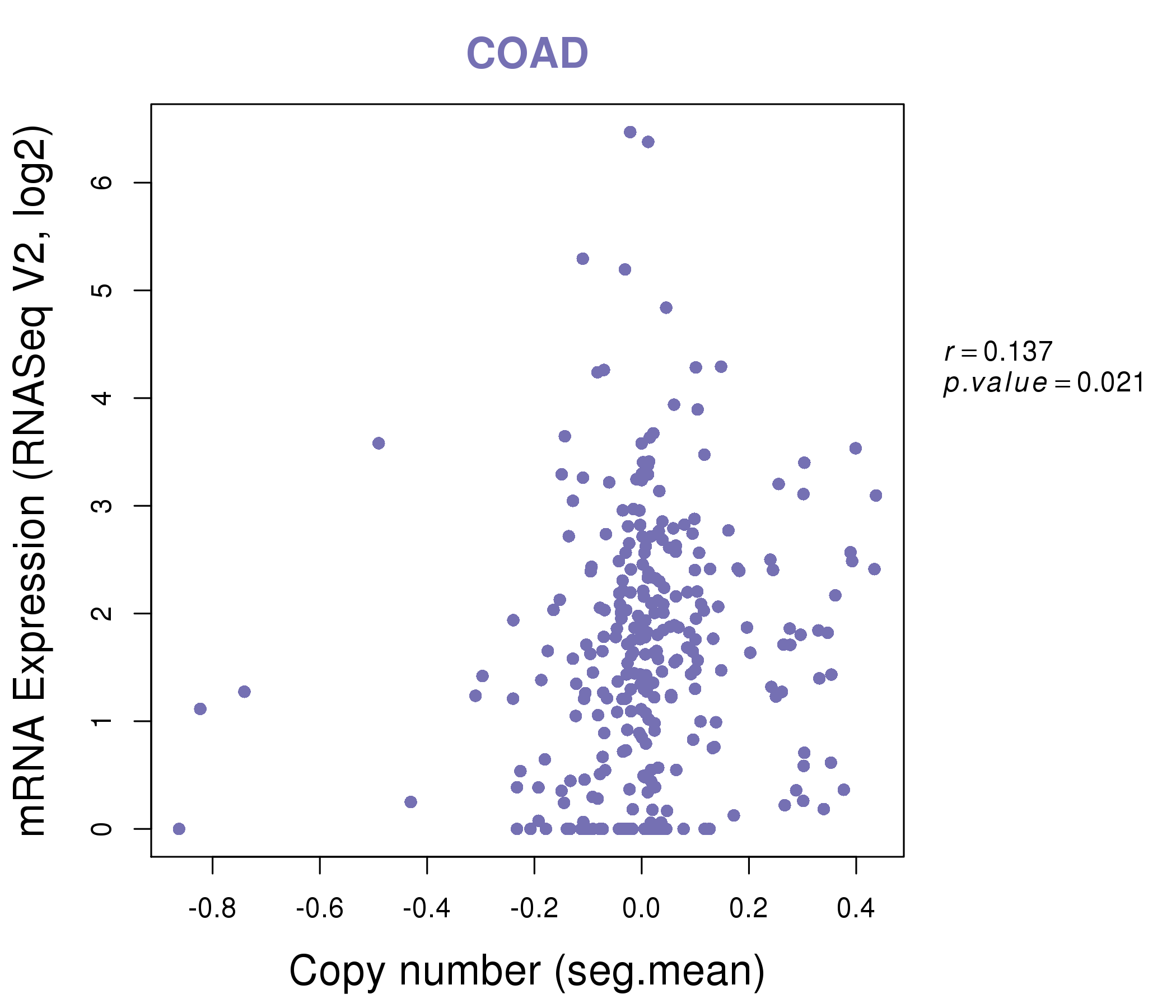 |
|
| Top |
| Gene-Gene Network Information |
| * Co-Expression network figures were drawn using R package igraph. Only the top 20 genes with the highest correlations were shown. Red circle: input gene, orange circle: cell metabolism gene, sky circle: other gene |
: Open all plots for all cancer types
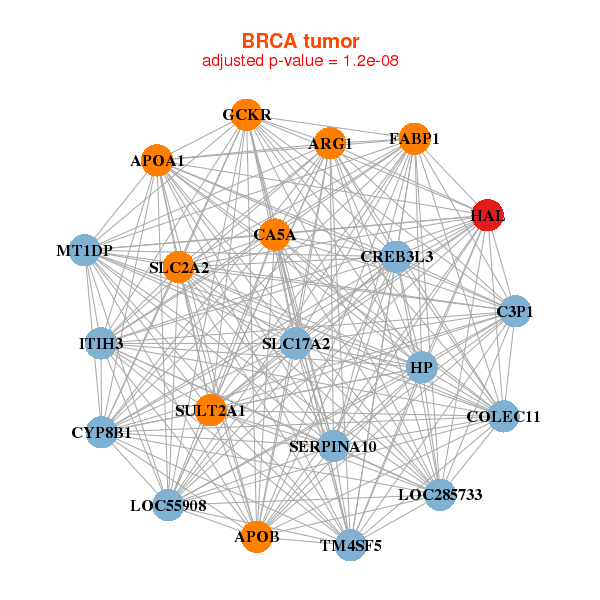 |
| ||||
| APOA1,APOB,ARG1,C3P1,CA5A,COLEC11,CREB3L3, CYP8B1,FABP1,GCKR,HAL,HP,ITIH3,LOC285733, LOC55908,MT1DP,SERPINA10,SLC17A2,SLC2A2,SULT2A1,TM4SF5 | ACSM2A,ACSM2B,AMN,APOC3,APOL4,TBATA,CHGA, DBH,GLYCTK,HAL,NDRG4,NTSR2,ORM1,ORM2, PDZD7,PHOX2B,RASL10B,SNORA14A,ST8SIA3,TAGLN3,TH | ||||
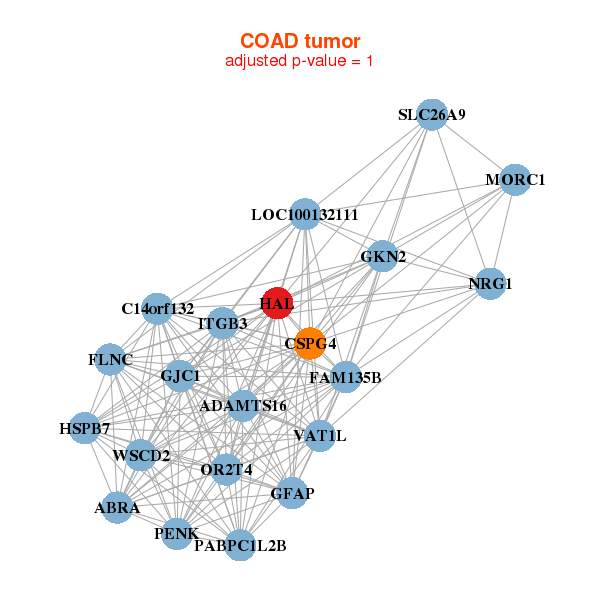 |
| ||||
| ABRA,ADAMTS16,C14orf132,CSPG4,FAM135B,FLNC,GFAP, GJC1,GKN2,HAL,HSPB7,ITGB3,LOC100132111,MORC1, NRG1,OR2T4,PABPC1L2B,PENK,SLC26A9,VAT1L,WSCD2 | ARL15,LSMEM1,C8orf34,CSN1S1,DTWD2,FAM13A-AS1,FAM91A1, FAR1,FASTKD1,GEN1,HAL,LOC440944,PFKFB2,PIWIL4, SLC19A2,SNHG12,SPAST,TRPM7,TTC19,USP45,ZNF600 |
| * Co-Expression network figures were drawn using R package igraph. Only the top 20 genes with the highest correlations were shown. Red circle: input gene, orange circle: cell metabolism gene, sky circle: other gene |
: Open all plots for all cancer types
| Top |
: Open all interacting genes' information including KEGG pathway for all interacting genes from DAVID
| Top |
| Pharmacological Information for HAL |
| DB Category | DB Name | DB's ID and Url link |
| * Gene Centered Interaction Network. |
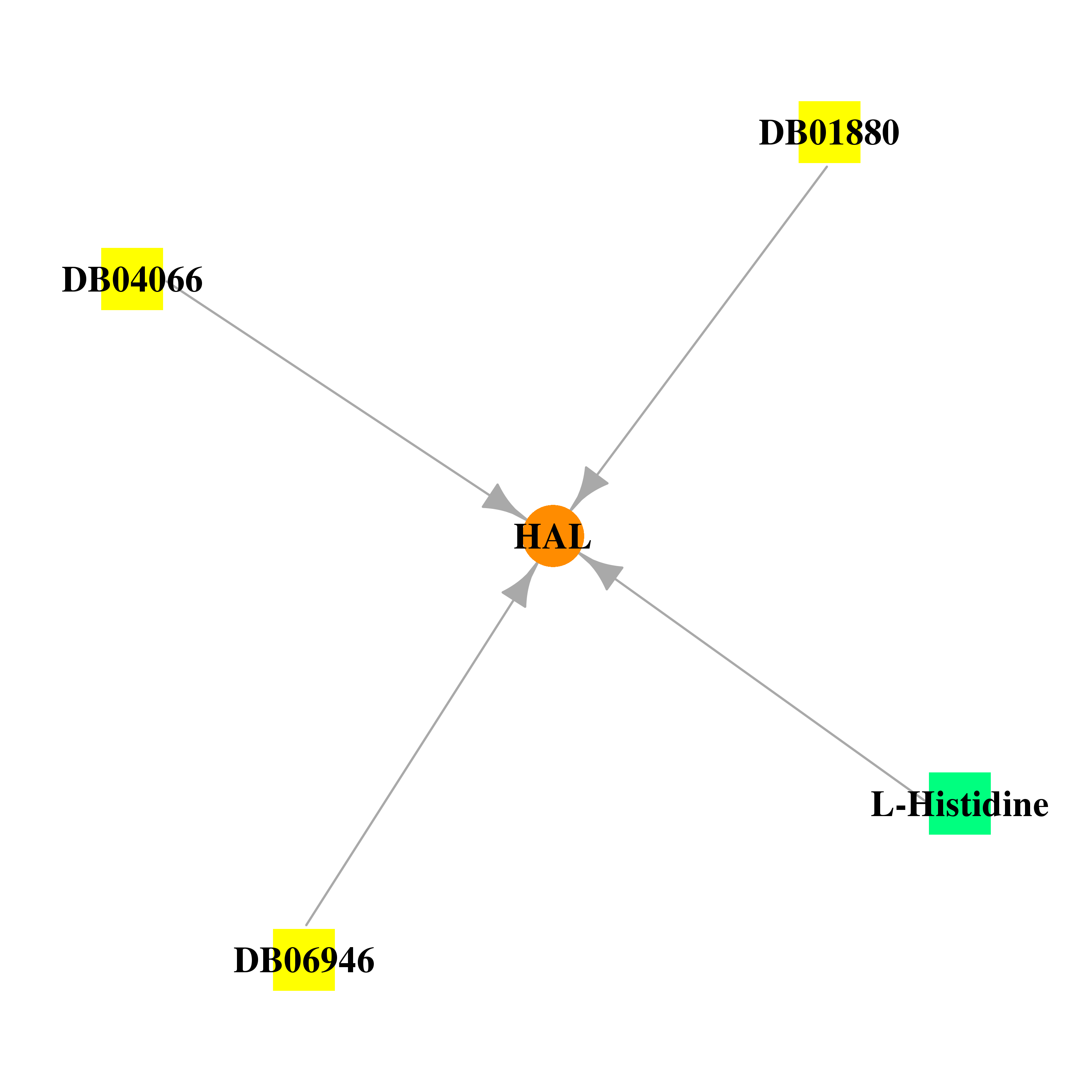 |
| * Drug Centered Interaction Network. |
| DrugBank ID | Target Name | Drug Groups | Generic Name | Drug Centered Network | Drug Structure |
| DB00117 | histidine ammonia-lyase | approved; nutraceutical | L-Histidine | 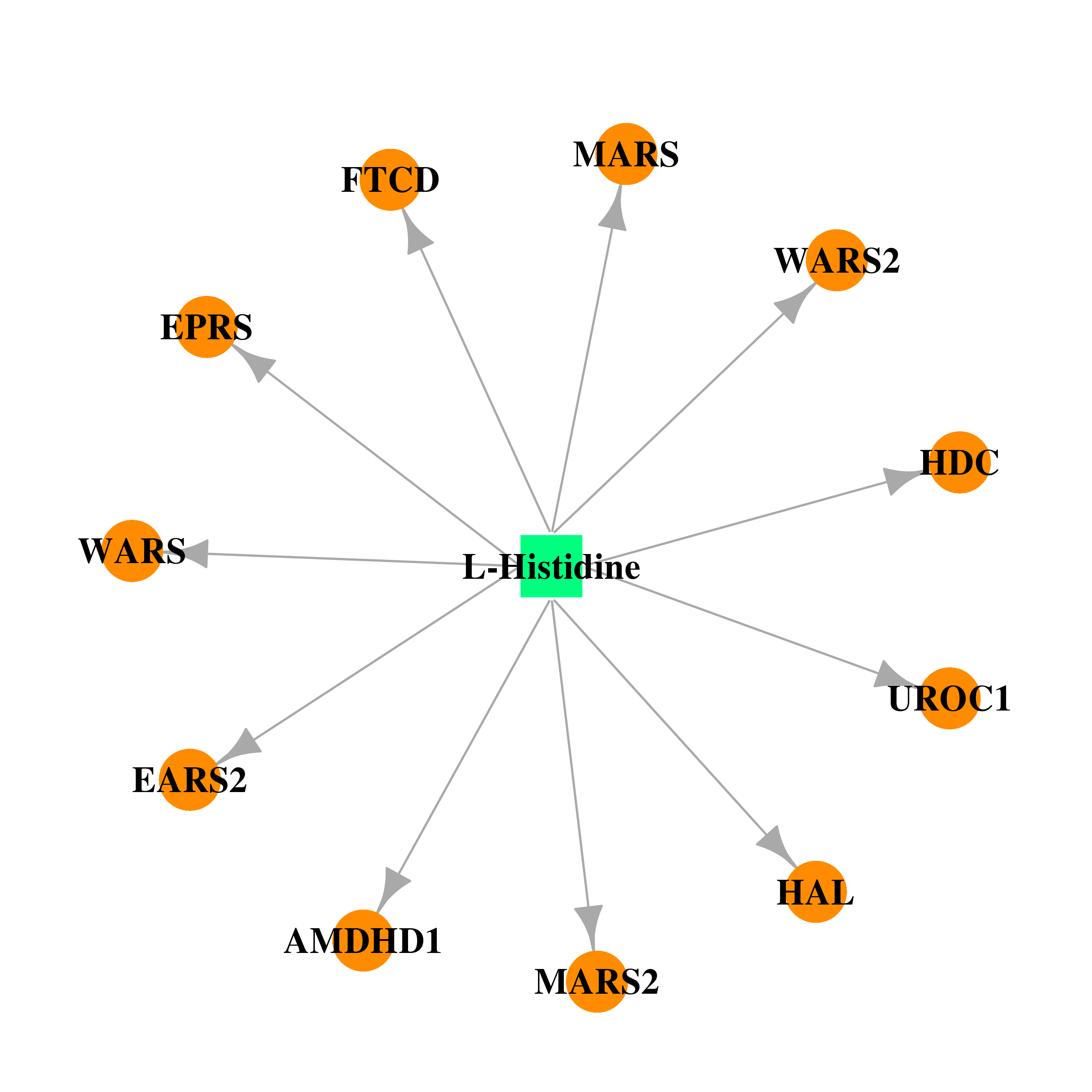 | 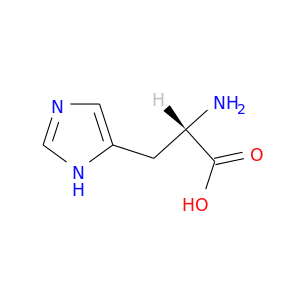 |
| DB06946 | histidine ammonia-lyase | experimental | (2S,3S)-3-(4-fluorophenyl)-2,3-dihydroxypropanoic acid | 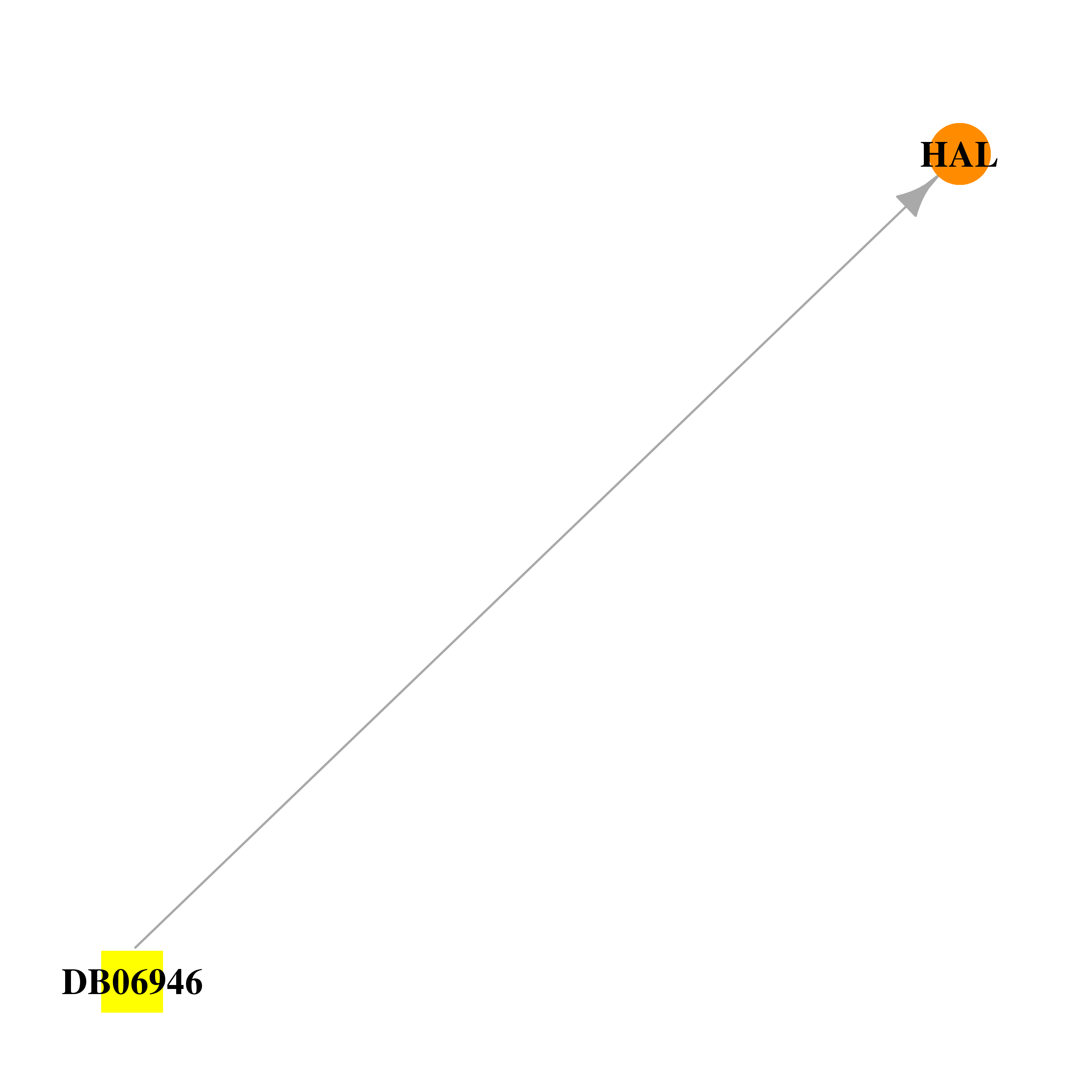 | 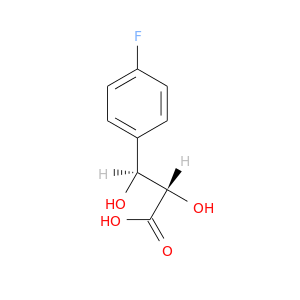 |
| DB01880 | histidine ammonia-lyase | experimental | 3,4-Dihydroxycinnamic Acid | 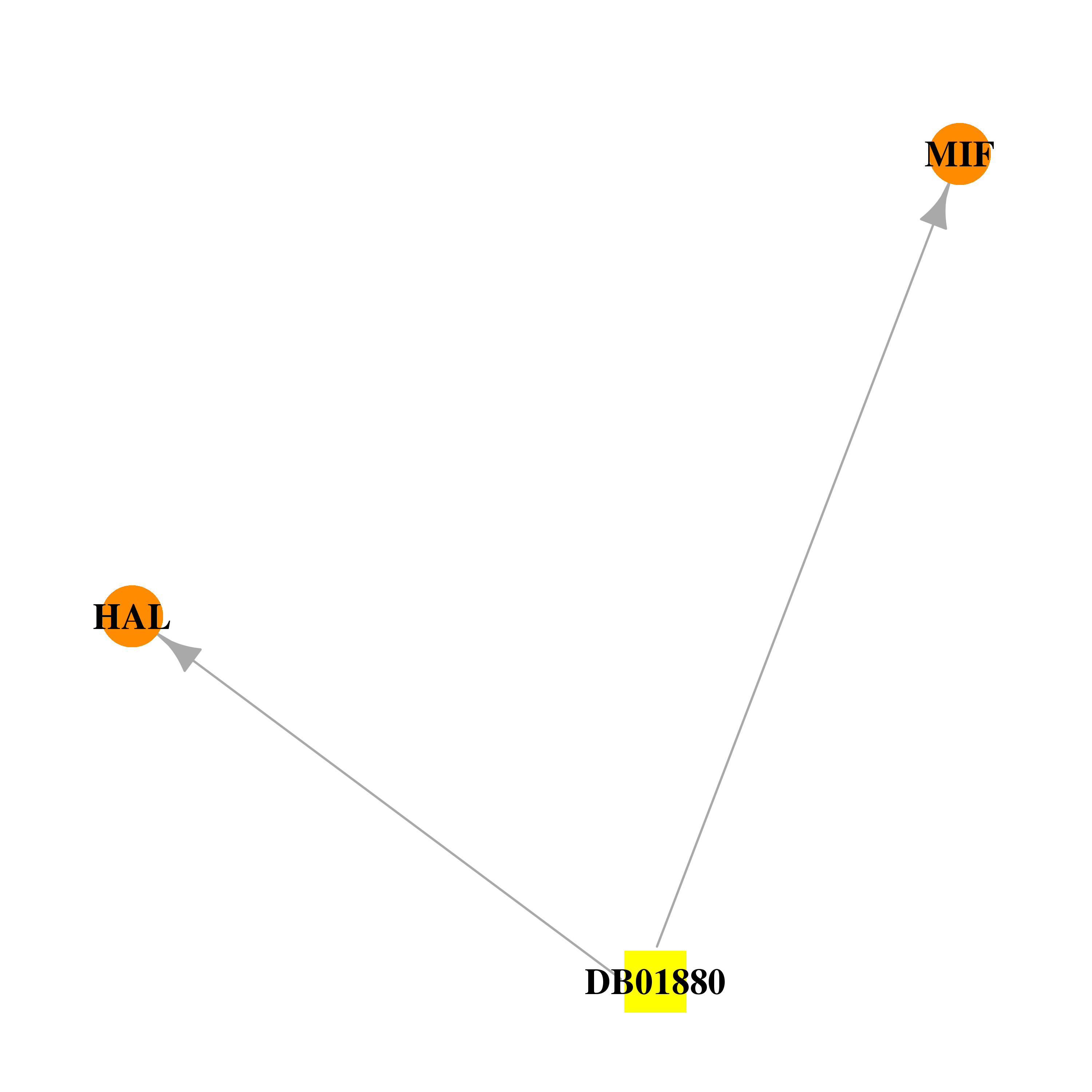 |  |
| DB04066 | histidine ammonia-lyase | experimental | Para-Coumaric Acid | 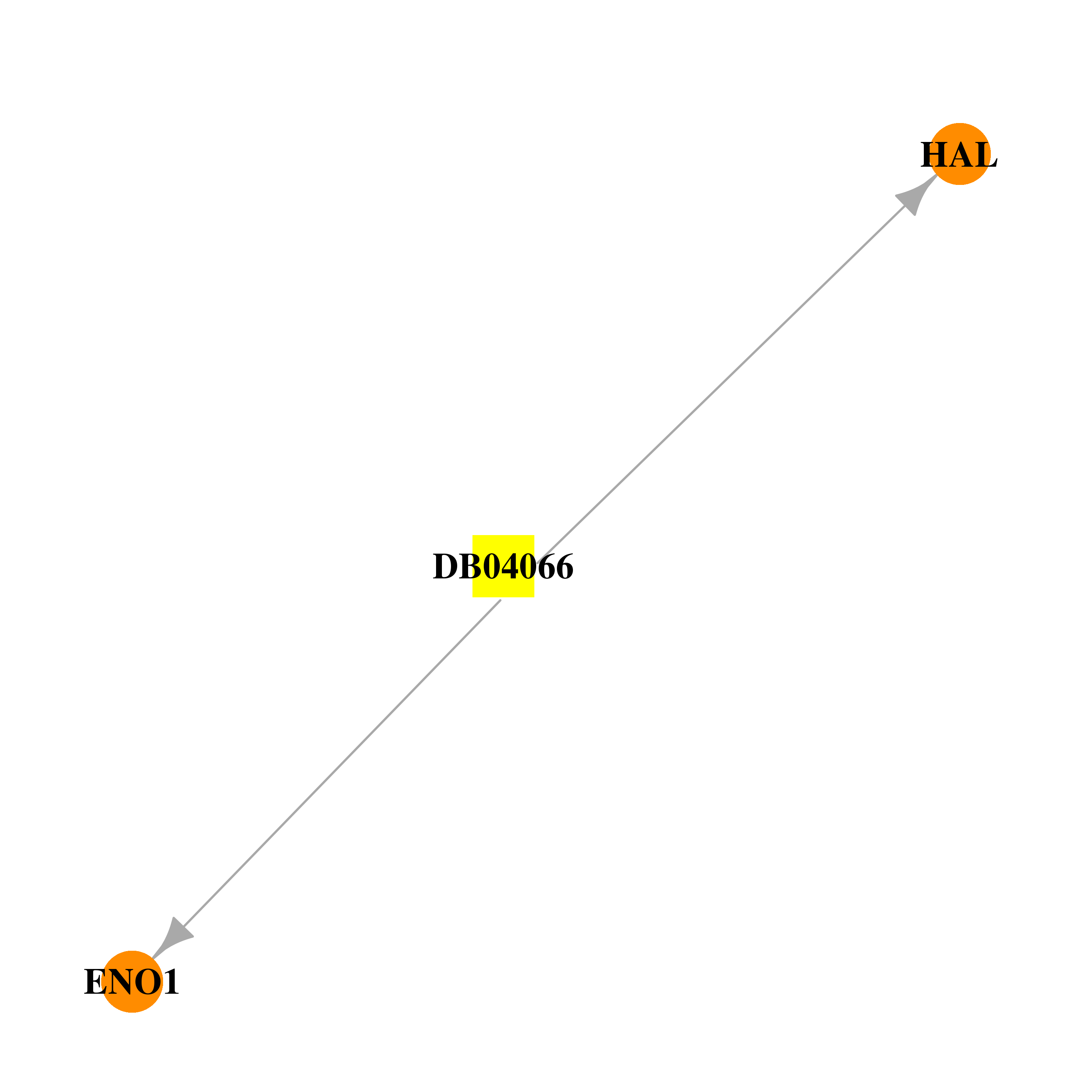 |  |
| Top |
| Cross referenced IDs for HAL |
| * We obtained these cross-references from Uniprot database. It covers 150 different DBs, 18 categories. http://www.uniprot.org/help/cross_references_section |
: Open all cross reference information
|
Copyright © 2016-Present - The Univsersity of Texas Health Science Center at Houston @ |






